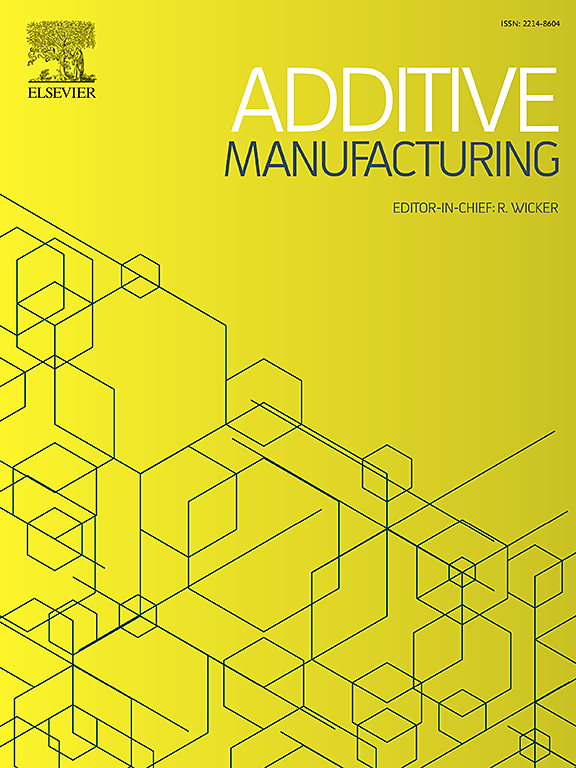Evolution of powder-entrapped pores in Ti–6Al–4V fabricated with powder bed fusion-laser beam process
IF 10.3
1区 工程技术
Q1 ENGINEERING, MANUFACTURING
引用次数: 0
Abstract
X-ray micro computed tomography (X-CT) of bulk powder bed fusion-laser beam (PBF-LB) Ti–6Al–4V samples shows that, within the optimal process window – where lack-of-fusion and keyhole porosity are minimized – higher laser power reduces the number density of powder-entrapped pores when hatch spacing, layer thickness, and laser spot size remain fixed. To gain insight into this observation, the X-CT measurements of powder-entrapped pores are combined with a computational model to simulate pore trajectories in the PBF-LB melt pool. More than 100,000 independent pore trajectories are simulated at two different combinations of laser power and scanning velocity, where the forces acting on the pores are quantified using melt pool temperatures, pressures, and fluid flow velocities from multi-physics simulations. The model is then used to predict the pore size distributions in bulk samples fabricated within the optimal process window at 150 W, 700 mm/s and 370 W, 1200 mm/s. At both laser power settings, the total number density of pores predicted by the model is within one order of magnitude of the experimental values. The model suggests that the differences in the pore size distributions measured with X-CT are caused by differences in melt pool overlap (i.e., remelting). Using the model, a process map is constructed to predict porosity as a function of hatch spacing and layer thickness, suggesting that the number density of powder-entrapped pores can vary by two orders of magnitude within the optimal process window. This result suggests that the elimination of powder-entrapped pores poses an obstacle to increasing build rates by increasing the hatch spacing and layer thickness. While previous investigations of pore evolution during PBF-LB focused on experimental approaches, this work will enable the development of model-driven processing strategies to promote pore elimination.

粉末床激光熔合制备Ti-6Al-4V粉末包埋孔的演变
对Ti-6Al-4V样品的X射线微计算机断层扫描(X μ ct)结果表明,在最佳工艺窗口内,当舱口间距、层厚和激光光斑尺寸保持不变时,较高的激光功率会降低粉末捕获孔的数量密度。为了深入了解这一观察结果,将X μ ct测量的粉末包裹孔隙与计算模型相结合,模拟了PBF-LB熔池中的孔隙轨迹。在两种不同的激光功率和扫描速度组合下,模拟了超过100,000个独立的孔隙轨迹,其中作用在孔隙上的力通过多物理场模拟的熔池温度、压力和流体流动速度来量化。然后,利用该模型预测了在最佳工艺窗口(150w, 700mm /s和370w, 1200mm /s)下制备的块状样品的孔径分布。在两种激光功率设置下,模型预测的孔隙总数密度与实验值相差一个数量级以内。该模型表明,X μ ct测量的孔径分布差异是由熔池重叠(即重熔)的差异引起的。利用该模型,构建了一个工艺图来预测孔隙率作为舱口间距和层厚的函数,表明在最佳工艺窗口内,粉末包裹孔隙的数量密度可以变化两个数量级。这一结果表明,消除粉末包裹孔隙是通过增加舱口间距和层厚来提高构建率的障碍。虽然之前对PBF-LB过程中孔隙演化的研究主要集中在实验方法上,但这项工作将使模型驱动处理策略的发展能够促进孔隙消除。
本文章由计算机程序翻译,如有差异,请以英文原文为准。
求助全文
约1分钟内获得全文
求助全文
来源期刊

Additive manufacturing
Materials Science-General Materials Science
CiteScore
19.80
自引率
12.70%
发文量
648
审稿时长
35 days
期刊介绍:
Additive Manufacturing stands as a peer-reviewed journal dedicated to delivering high-quality research papers and reviews in the field of additive manufacturing, serving both academia and industry leaders. The journal's objective is to recognize the innovative essence of additive manufacturing and its diverse applications, providing a comprehensive overview of current developments and future prospects.
The transformative potential of additive manufacturing technologies in product design and manufacturing is poised to disrupt traditional approaches. In response to this paradigm shift, a distinctive and comprehensive publication outlet was essential. Additive Manufacturing fulfills this need, offering a platform for engineers, materials scientists, and practitioners across academia and various industries to document and share innovations in these evolving technologies.
 求助内容:
求助内容: 应助结果提醒方式:
应助结果提醒方式:


